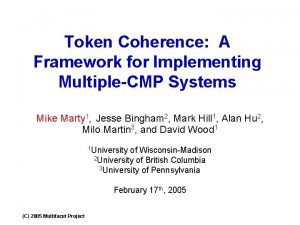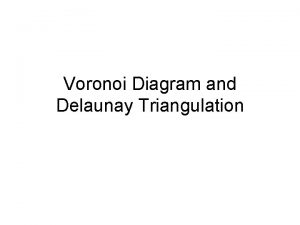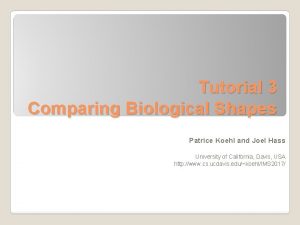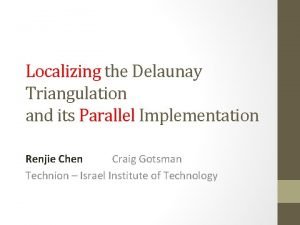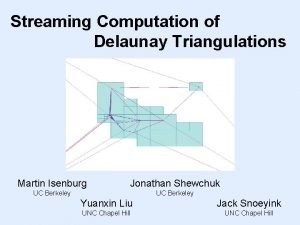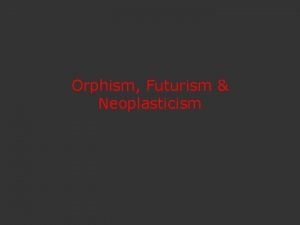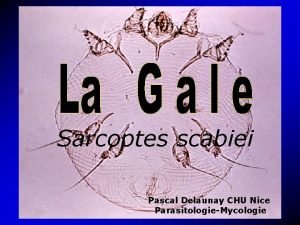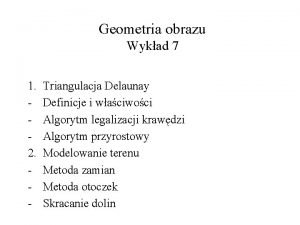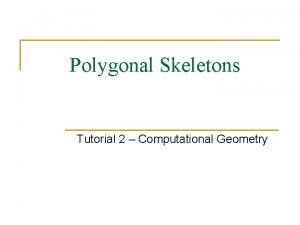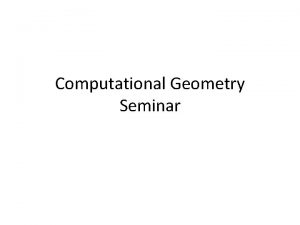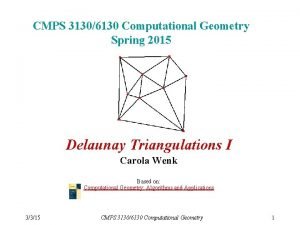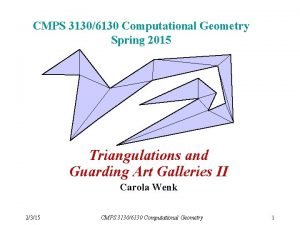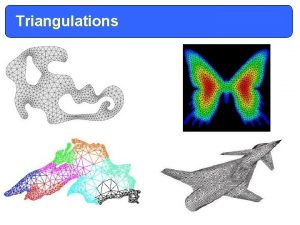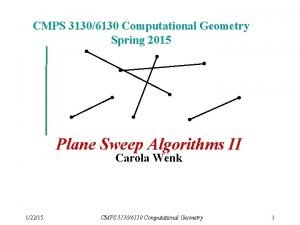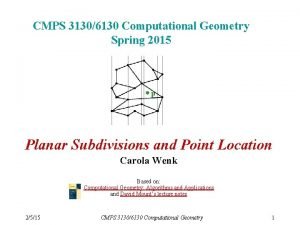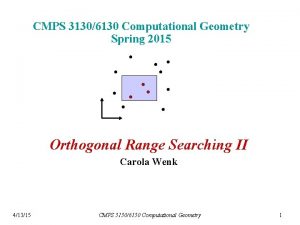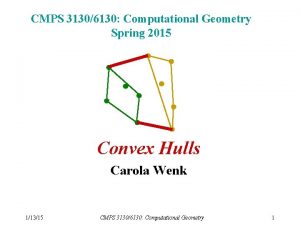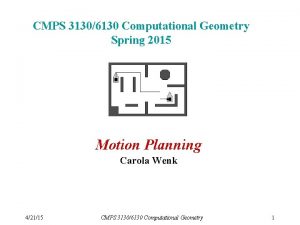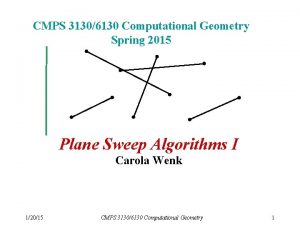CMPS 31306130 Computational Geometry Spring 2015 Delaunay Triangulations











- Slides: 11

CMPS 3130/6130 Computational Geometry Spring 2015 Delaunay Triangulations II Carola Wenk Based on: Computational Geometry: Algorithms and Applications 3/5/15 CMPS 3130/6130 Computational Geometry 1

Applications of DT • Terrain modeling: – Model a scanned terrain surface by interpolating the height using a piecewise linear function over R 2. – Angle-optimal triangulations give better approximations / interpolations since they avoid skinny triangles 3/5/15 CMPS 3130/6130 Computational Geometry 2

Applications of DT • All nearest neighbors: Find for each p P its nearest neighbor q P; q p. p – Empty circle property: p, q P are connected by an edge in DT(P) there exists an empty circle passing through p and p. Proof: “ ”: For the Delaunay edge pq there must be a Voronoi edge. Center a circle through p and q at any point on the Voronoi edge, this circle must be empty. “ ”: If there is an empty circle through p and q, then its center c has to lie on the Voronoi edge because it is equidistant to p and q and there is no site closer to c. – Claim: Every p P is adjacent in DT(P) to its nearest neighbor q P. Proof: The circle centered at p with q on its boundary has to be empty, so the circle with diameter pq is empty and pq is a Delaunay edge. q q p – Algorithm: Find all nearest neighbors in O(n) time: Check for each p P all points connected to p with a Delaunay edge. • Minimum spanning tree: The edges of every Euclidean minimum spanning tree of P are a subset of the edges of DT(P). 3/5/15 CMPS 3130/6130 Computational Geometry 3

Randomized Incremental Construction of DT(P) • Start with a large triangle containing P. • Insert points of P incrementally: – Find the containing triangle – Add new edges – Flip all illegal edges until every edge is legal. 3/5/15 CMPS 3130/6130 Computational Geometry 4

Randomized Incremental Construction of DT(P) pr pr • • An edge can become illegal only if one of its incident triangles changes. Check only edges of new triangles. Every new edge created is incident to pr. Every old edge is legal (if pr is on on one of the incident triangles, the edge would have been flipped if it were illegal). • Every new edge is legal (since it has been created from flipping a legal edge). 3/5/15 CMPS 3130/6130 Computational Geometry 5

Pseudo Code 3/5/15 CMPS 3130/6130 Computational Geometry 6

History The algorithm stores the history of the constructed triangles. This allows to easily locate the triangle containing a new point by following pointers. • Division of a triangle: Store pointers from the old triangle to the three new triangles. • Flip: Store pointers from both old triangles to both new triangles. 3/5/15 CMPS 3130/6130 Computational Geometry 7

DT and 3 D CH Theorem: Let P={p 1, …, pn} with pi=(ai, bi, 0). Let p*i =(ai, bi, a 2 i+ b 2 i) be the vertical projection of each point pi onto the paraboloid z=x 2+ y 2. Then DT(P) is the orthogonal projection onto the plane z=0 of the lower convex hull of P*={p*1, …, p*n}. P* P Pictures generated with Hull 2 VD tool available at http: //www. cs. mtu. edu/~shene/NSF-2/DM 2 -BETA 3/5/15 CMPS 3130/6130 Computational Geometry 8

DT and 3 D CH Theorem: Let P={p 1, …, pn} with pi=(ai, bi, 0). Let p*i =(ai, bi, a 2 i+ b 2 i) be the vertical projection of each point pi onto the paraboloid z=x 2+ y 2. Then DT(P) is the orthogonal projection onto the plane z=0 of the lower convex hull of P*={p*1, …, p*n}. Pictures generated with Hull 2 VD tool available at http: //www. cs. mtu. edu/~shene/NSF-2/DM 2 -BETA 3/5/15 CMPS 3130/6130 Computational Geometry 9

DT and 3 D CH Theorem: Let P={p 1, …, pn} with pi=(ai, bi, 0). Let p*i =(ai, bi, a 2 i+ b 2 i) be the vertical projection of each point pi onto the paraboloid z=x 2+ y 2. Then DT(P) is the orthogonal projection onto the plane z=0 of the lower convex hull of P*={p*1, …, p*n}. Pictures generated with Hull 2 VD tool available at http: //www. cs. mtu. edu/~shene/NSF-2/DM 2 -BETA 3/5/15 CMPS 3130/6130 Computational Geometry 10

DT and 3 D CH Theorem: Let P={p 1, …, pn} with pi=(ai, bi, 0). Let p*i =(ai, bi, a 2 i+ b 2 i) be the vertical projection of each point pi onto the paraboloid z=x 2+ y 2. Then DT(P) is the orthogonal projection onto the plane z=0 of the lower convex hull of P*={p*1, …, p*n}. p*i, p*j, p*k form a (triangular) face of LCH(P*) The plane through p*i, p*j, p*k property leaves all remaining points of P of unit above it paraboloid The circle through pi, pj, pk leaves all remaining points of P in its exterior pi, pj, pk form a triangle of DT(P) Slide adapted from slides by Vera Sacristan. 3/5/15 CMPS 3130/6130 Computational Geometry 11
